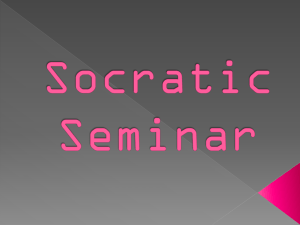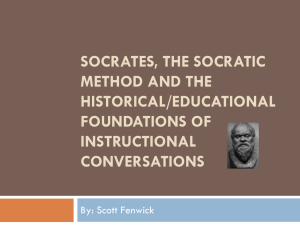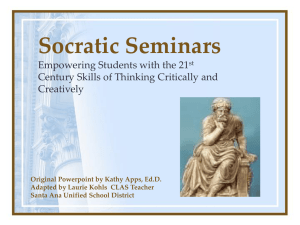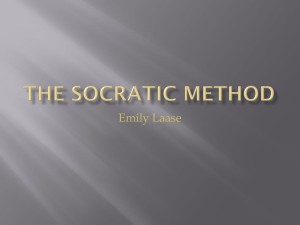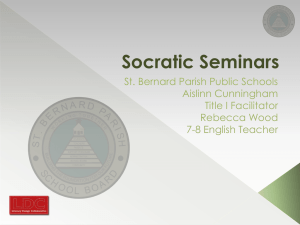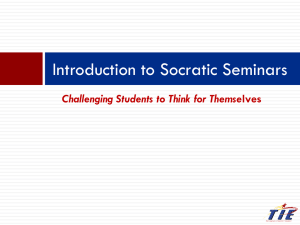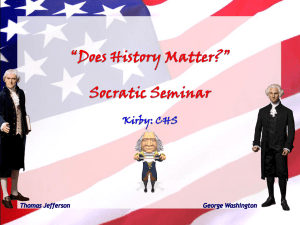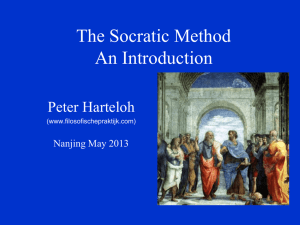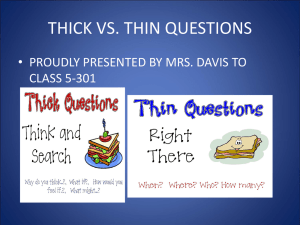Introducing Students to Socratic Circles
advertisement
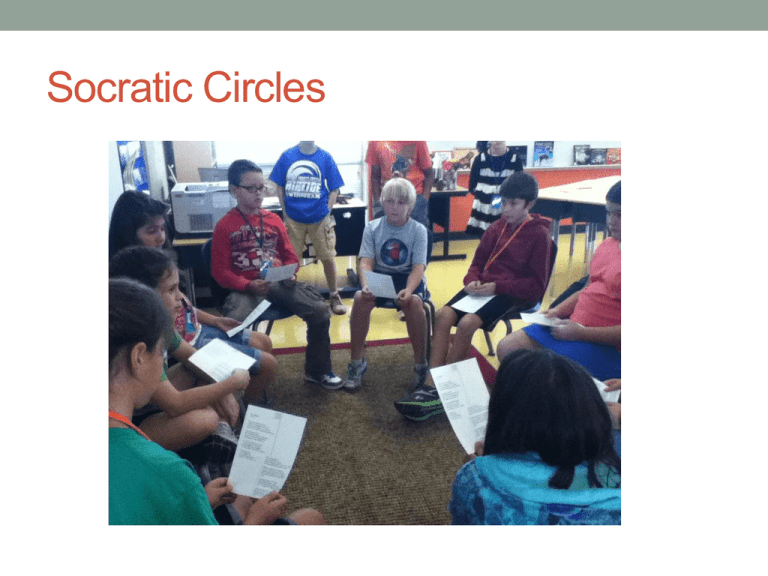
Socratic Circles What is a Socratic Circle? A Socratic Circle is a way of teaching founded by the Greek philosopher “Socrates”. Socrates believed that: • Students learn best by asking questions. • It is the teacher’s job to moderate the discussion instead of leading the discussion. A Peek into “Socratic Circles” As you watch the video….take notes 1. What is the teacher’s role? 2. What is the students’ role? 3. How is this learning experience like/unlike what you have experienced in the classroom? Why do we have Socratic Circles? • Socratic Circles help us engage a text in class. • The thought process when we work together to understand a text, will help everyone’s understanding. • You will gain a deeper understanding as you discuss your reactions, opinions, and ask questions as you apply the information to your own lives and the world around you. How do we prepare for a Socratic Seminar? • You will be given a text to read and a Socratic Circle Prep Worksheet. • Your job is to carefully read the text and then write down important questions and quotations. What type of questions should I ask during the Socratic Circle? Ask questions that do not have a simple “Yes” or “No” answer. • Example: “As I was reading the text, I was wondering… • Is anyone confused about…? • I think the author was trying to explain/prove…What do you think? Thin Questions • Thin questions deal with specific content or words you don’t know. • Answers to thin questions are short and close-ended. Thick Question • A question that requires more than a one or two word response. • It deals with the big picture and large concepts • Thick answers are involved, complex, and open-ended. Goldilocks and the Three Bears • • • • • • • • • • Who were the main characters in the story? Thin Where did this story take place? Thin What does the word “porridge” mean? Thin How would you feel if someone broke into your house? Thick What is the lesson of this story? Thick Thinking Stems: Questioning THIN • Who…? • What…? • When…? • Where…? • How many…? • What does the word ___ mean? THICK • Why…? • • • • • • • • • What if…? What might…? How would I feel…? How does ___ feel about…? I wonder why…? How come…? How could…? What is happening…? So what…? Support your ideas with evidence… • Explain how … • Explain why … • Use the numbered lines from the text when asking or answering questions or giving an opinion. • Ex: In line 25 the text states that the bear was embarrassed…. Connect your questions/opinions to other texts or the world • Imagine … • What would happen if …? • How is this text similar to other books or articles you’ve read? • How is this text related to something happening in the world around you? What will the Socratic Circle look like? • The classroom will be arranged in a circle. • Mrs. Kruse will be facilitating, but not providing answers. • You will be discussing…no need to raise your hand. • Everyone speaks clearly and participates. What are some guidelines we might need? • Think, Pair Share Guidelines for our Socratic Circle… • Speak Clearly. • Listen and look at each other when you speak. • One person speaks at a time. • Respond to the person who asks the question. • Use evidence from the text to support yourself. • Always treat each other with respect. Which is more important? Pitcher Catcher Which is more important? Writer Reader Annotating Text “Having a conversation with words on a page” (Claggett, Reid, Vinz 1998) In a Socratic Circle you will learn to… • Listen more effectively • Learn from others to what others say. • Explain your ideas more clearly • Speak and work well with others • Admit when you’re wrong • Be more open-minded • Analyze and question what you have read or heard. • Relate text to your life and/or the world around you. • Realize that sometimes there is no right answer!

